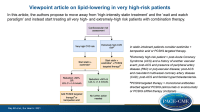Viewpoint article on lipid-lowering in very high-risk patients
A recent article in Eur Heart J describes to move away from ‘high-intensity statin treatment’ and ‘the wait and watch paradigm’ and instead start treating all very high- and extremely high-risk patients with combination therapy as the basic standard of care.
News - Oct. 18, 2021High-intensity statins are the established, recommended cornerstone for atherosclerotic cardiovascular disease (ASCVD) prevention. However, there remains a large gap between guideline-recommended low-density lipoprotein (LDL) cholesterol target levels and achieved levels in current practice.
Since the achieved cardiovascular benefit is independent of the mode of LDL cholesterol lowering, the authors of this article propose to move away from the concept of high-intensity statin therapy to one of high-intensity lipid-lowering for very-high risk patients, such as those with ASCVD. This can be achieved by simultaneous combination of statin and ezetimibe therapy and, if needed, addition of bempedoic acid or proprotein convertase subtilisin/kexin type 9 (PCSK9) targeted therapy.
At a population level, this combination therapy approach avoids the “stepwise wait-and-watch approach” ensuring both early and greater reductions in LDL cholesterol for those at highest risk who benefit most from intensive lipid-lowering regimens.

